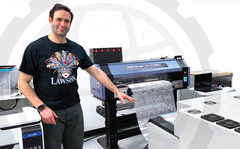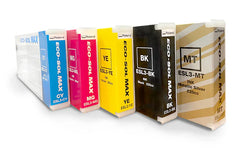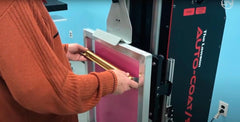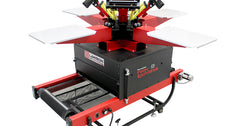Having a steady workflow establishes high quality silk screens due to consistency across the entire operation.
Best Practices for Your Screen Department
Experienced screen printers understand that establishing a procedure and workflow is a key ingredient in producing the best screen printed t-shirts and garments. Having a steady workflow establishes high quality silk screens because there is consistency across the entire t-shirt printing operation. While most printers understand this, the screen room and mesh screen frame preparation do not always have a proper workflow procedure. Below are some tips to apply to your screen frame operation. Implementing these exposure and screen preparation techniques in your screen room that will result in better emulsion stencils, better exposure, less pinholes when printing and faster production.
Tips on how to get the best screen print exposure
1. Check Mesh Tension
Having a properly tensioned mesh on your screen printing frames provides lots of benefits, including better, sharper looking prints and easier manual and automatic printing. No matter if you use static aluminum screen printing frames, rollers frames or, retensionable frames, periodically check the tension with a tension meter. This is a valuable screen printing shop tool that lasts a lifetime.
2. Cleanliness is Key
Thoroughly clean and degrease each screen. This simple preparation step is often overlooked. Spending an extra minute making sure all the plastisol ink, or water-based ink, is removed and all the tape is gone will help increase the longevity of your screen. Ultimately this will minimize mesh restretches, or buying new frames. Also, screen printing emulsion does not properly adhere to t-shirt ink and tape, so missing a spot will cause problems later.
3. Properly Apply Screen Printing Emulsion
Everyone has their own emulsion coating technique. This coating variation affects the screen printing emulsion stencil. If possible have the same person coat all your screens; or, better yet, try to automate your screen coating process. Different printing factors can often determine whether to do a 1/1, 2/1 or 2/2 emulsion coating to your screen printing frame. A general guideline is to have an emulsion-over-mesh (EOM) ratio of approximately 13% - 18%.
4. Check the Humidity
Your screen print shop’s humidity affects many things. Many shops are not climate controlled which causes big swings in the humidity levels especially as the seasons change. Applying emulsion to mesh in the same area as you reclaim and wash out means the humidity can vary greatly within the day. This can affect how quickly an emulsion coated screen dries. A screen drying cabinet is the best way to control this variable (a dehumidifier can act as a substitute).
5. Clean Your Exposure Unit
Clean Your Exposure Unit - No matter whether your exposure unit is fluorescent tubes, metal halide, or LED, make sure to clean the glass. Dirt, dust and lint on the glass is a main cause for pinholes that show up while screen printing on-press. A can of Sprayaway glass cleaner is fantastic for screen printing shops.
6. Use an Exposure Calculator
Different emulsions and screen thread mesh counts expose at different rates. Experimenting with an exposure calculator to find the best exposure times provides long term benefits to your screen printing shop. Remember to keep track of your results. Post your chart of exposure times near your exposure unit to help remind the screen room operator to change it up depending on the emulsion and mesh count for each frame.
7. Cross Train Across Related Departments
Teaching your staff how their actions affect the entire process helps streamline the screen printing workflow. For example, having your artist understand the principles of screen mesh helps when printing color separations. It is best if your artist can print on the film positive the mesh count that should be used for each color. Removing uncertainty in the screen room is always positive as it allows anyone to rotate through the department with minimal training.
8. Have Prepared Screens
The best screen printing shops have emulsion coated screens ready to expose at all times. This helps get that rush t-shirt order out the door or quickly start printing again if a screen rips on-press. The last thing you want is to be waiting around while screens dry. Spending a few minutes preparing can save hours later. Be prepared for anything. Part of being prepared is making sure you have enough screen printing frames in inventory. No one wants to panic about not having enough screens. Keep track of how many screen printing frames are in use or waiting to be reclaimed versus what you need. Since space is often at a premium for most screen printing shops, think about using panel frames. This is an easy way to store screens without taking up valuable floor space.
Using these screen room best practices allows every screen printing shop to develop a workflow for producing the best screen printing images. Having a clean screen, great emulsion-over-mesh (EOM) coverage and a clean exposure unit produces the best exposed screen. In turn, this makes it easier for the press operator to print and allows for faster product. Take action now and start producing better screens prints today.







